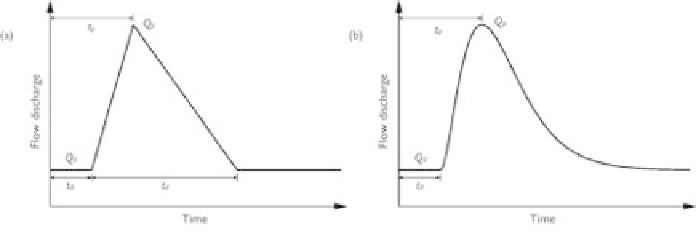Geoscience Reference
In-Depth Information
taken into account by solving the corresponding stage-discharge equations in the flow
model. Bank toe erosion and mass failure are simulated using Osman and Thorne's
(1988) method. The eroded bank materials are treated as side discharge in the sediment
transport equations. The outputs of the channel model are the runoff and sediment
yields from both uplands and channels, channel morphological changes, etc.
8.3.2 Integration approaches
The three modeling components (landscape analysis, watershed simulation, and chan-
nel simulation) can be integrated in several ways. The first approach is to combine
them into a single modeling system. Such an integrated system is very convenient for
data transfer and manipulation but very expensive to develop. The second approach
is to develop a separate subsystem for each modeling component, with common data
file formats being set up for data transfer between the modeling components. The
third approach is to develop two subsystems: one combines the landscape analysis
and channel simulation, and the other combines the landscape analysis and watershed
simulation. Data transfer is still needed between the two subsystems. In order to make
the two subsystems compatible, the landscape analysis tools used by them should be
identical or very similar. The integration of CCHE1D and AGNPS (or SWAT) adopts
the third approach (Vieira and Wu, 2002).
8.3.3 Scale issues
Time scale
The watershed model uses a daily time step, while the channel model employs a time
step in the order of minutes. It is not efficient to use a common time step for both com-
ponents in the integrated modeling system. The more widely adopted approach uses
different time steps. However, it is needed to convert the daily runoff and sediment
loads calculated by the watershed model to continuous hydrographs for channel sim-
ulation. For runoff, a triangular or gamma-function hydrograph shown in Fig.8.13 is
often used. To define the triangular or gamma-function hydrograph, the base flow dis-
charge (
Q
0
), peak flow discharge (
Q
p
), starting time (
t
0
), and time to peak (
t
p
) should
be provided. The duration (
t
d
) is additionally required for the triangular hydrograph,
and a shape factor for the gamma-function hydrogragh. These parameters depend
Figure 8.13
Typical hydrographs: (a) triangular and (b) gamma-function.

